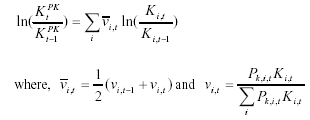International Comparison of Productivity among Asian Countries (ICPA) Project
Methodology
The methodology is based on the growth accounting framework, with internationally comparable measurements of the service flow of labor, capital, and other intermediate inputs; gross output; and productivity at economy-wide and industry levels.* This framework must be consistently related to national accounts statistics and input-output tables of each country.
Common industrial classification is provided in Table A of Appendix 1. Labor input and capital input are derived from quantity and price data by type, as are described in Table B and Table C, respectively. Proper aggregation of labor and capital inputs based on detail data by type allows us to make a distinction between quantity and quality improvement for each factor input. Divisia index of capital service (KPK) is derived as follows,

This capital service index is a weighted average of capital stock (Ki) for each type 'i' by the share of rental services from this type of capital stock  . Capital service price (Pk, i) is based on the theory of rental service price, with asset price data, rate of depreciation, rate of return on asset and proper tax treatment in rental service equation. The growth rate of rental service index can be decomposed into the following two parts, i.e., quantity growth and quality growth.
. Capital service price (Pk, i) is based on the theory of rental service price, with asset price data, rate of depreciation, rate of return on asset and proper tax treatment in rental service equation. The growth rate of rental service index can be decomposed into the following two parts, i.e., quantity growth and quality growth.

Labor input and intermediate input (energy, material and service) can be estimated in the same framework. Labor input is estimated as a weighted average of hours worked by hourly wage by type of labor, and divisia index of intermediate input (energy, material and service) can be derived from input output tables. Finally, growth accounting decomposition of output (Y) can be conducted as follows,

This framework can be applied to the level comparison across countries as well. Growth accounting decomposition of output Y in country 'j' as compared to country 'i' can be described as follows.

* The analytical framework on international comparison of TFP growth and level is provided in Kuroda et. al. (1996). Empirical works of this framework include Kuroda and Numura (1999), Jorgenson et. al. (2002) and Keio University (1996).

